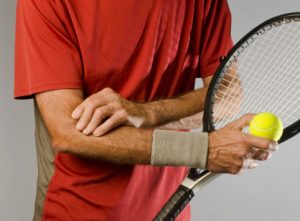 Tennis elbow, or lateral epicondylitis, is a condition that encompasses the overuse of the forearm, arm, and hand muscles, which creates elbow pain. Although it is commonly referred to as tennis elbow, it is not only experienced by tennis players; the term only came about because the condition was quite common among tennis players.
Tennis elbow, or lateral epicondylitis, is a condition that encompasses the overuse of the forearm, arm, and hand muscles, which creates elbow pain. Although it is commonly referred to as tennis elbow, it is not only experienced by tennis players; the term only came about because the condition was quite common among tennis players.
The pain experienced with tennis elbow is due to inflamed tendons that join the forearm muscles with the outside of the elbow. Repetitive motions cause damage to these tendons, causing pain in the elbow.
Study Shows Regular Tennis Elbow Cures Naturally without Any Treatment
Advertisement
Researchers in Norway have uncovered that frequent tennis elbow can heal on its own without treatments such as steroid injection. A surgeon in New York City, Dr. Joshua Dines, said, “I’m not surprised because that’s really been the classic teaching. The number that’s often cited is that 90 percent of tennis elbow, golfer’s elbow, will get better by the end of the year no matter what you do.”
First author, Dr. Morten Olaussen, added, “It is interesting to note that after one year, as much as one-third of the patients still reported considerable discomfort.” Previous research revealed physical therapy could help treat tennis elbow, but the latest findings found it ineffective.
Researchers looked at outcomes from 177 Norwegian patients with tennis elbow. Symptoms of tennis elbow were experienced for at least three months. Individuals were put into one of three groups: no treatment except pain relief drugs, physical therapy with steroid injections, and physical therapy with two placebo injections.
Patients were tracked for up to one year, and by the end, 157 patients completed the study.
Recovery from tennis elbow was shown to be the same among all three groups. Additionally, physical therapy and steroid injections were linked with worsening conditions at 12 and 26 weeks. Steroid injections were alleviating pain but did not aid in the repair of tendons.
Dines added, “If you get through about six months and haven’t gotten better with some sort of conservative treatment, that’s the group that’s going to go on to need surgery.”
The findings were published in BMC Musculoskeletal Disorders.
Natural Treatments for Severe Tennis Elbow
Natural treatments for tennis elbow involve rest, ice, painkillers, and a tennis elbow brace. If your arm is overworked, rest it. If it hurts, ice it and use painkillers. And if you have to use it again, use a tennis elbow brace.
Other nature treatment methods you can try include:
- Ice or heat pack: Alternating between cold and hot packs can help reduce inflammation and reduce pain.
- Deep tissue massage: A deep tissue massage can improve blood flow and reduce inflammation, which are keys to reducing pain associated with severe tennis elbow.
- Fenugreek seeds: Create a paste with fenugreek seeds and milk by first soaking the seeds overnight. Grind up the seeds in the morning and mix them with milk to create a thick mixture. Apply the paste to the affected area and leave on for one to two hours before rinsing. This works due to fenugreeks strong anti-inflammatory properties.
- Potato: Boil a couple of potatoes and mash them up immediately. Wrap the potatoes in a clean washcloth and tie it up. Apply to the elbow area for around 30 minutes. Potatoes are also high in anti-inflammatory properties.
- Celery seeds: Mix the juice from the celery seeds with warm water and mix well. Drink the mixture at least two to three times a day.
- Pineapple: Consume fresh pineapple or drink pineapple juice because it is high in vitamins which can help speed up recovery.
Learning proper technique when performing activities is also important for treating tennis elbow and ensuring it does not come back.
The common causes of tennis elbow
 The primary cause of tennis elbow is overuse. When damage is done to specific forearm muscles, it can lead to inflammation and pain. Other activities aside from sports can also contribute to overuse of the muscles that affect tennis elbow. Tennis elbow affects other occupations; plumbers, painters, carpenters, autoworkers, cooks, and even butchers all endure repetitive motions, which can increase their risk of tennis elbow.
The primary cause of tennis elbow is overuse. When damage is done to specific forearm muscles, it can lead to inflammation and pain. Other activities aside from sports can also contribute to overuse of the muscles that affect tennis elbow. Tennis elbow affects other occupations; plumbers, painters, carpenters, autoworkers, cooks, and even butchers all endure repetitive motions, which can increase their risk of tennis elbow.
Age can lead to weaker tendons as well due to many years of the same repetitive motions. Lastly, sometimes the cause for tennis elbow is unknown, which is called insidious tennis elbow.
Symptoms Showing You Have a Tennis Elbow Problem
If you are unsure whether you have tennis elbow or another condition, look out for these symptoms:
- Pain that slowly increases around the outside of your elbow – may appear suddenly
- Pain is worse when shaking hands or grasping objects
- Pain is worse when the wrist is moved with force – using tools, opening jars, etc.
Tennis Elbow Prevention
A good way to prevent tennis elbow is by stretching and strengthening the muscles in the forearm. Other tennis elbow prevention tips include:
- Staying in good shape
- Using correct technique during activities
- Using appropriate equipment for your abilities
- Avoiding overuse of the muscles, avoiding repetitive motions
- Strengthening muscles in shoulders, back, and upper arms
- Wearing a counterforce brace during strenuous activities
Exercises for Tennis Elbow
Advertisement
Effective exercises to strengthen your muscles and prevent tennis elbow include:
- Eccentric exercises: Hold a light weight in your hand and raise your wrist all the way up and all the way down. Alternate with your inner forearm down and then again facing up.
- Triceps stretch: Bring your arm up to the back of your head – bent at the elbow. Lightly tug on the elbow to elongate the stretch.
- Ball squeeze: Grasp and continuously squeeze and release a squeeze ball.
- Drawing the sword: Step on a resistance band with one foot and grasp one hand with the opposite hand. Raise your arm across your body then return it back down.
- Bicep curls: With a weight in hand raise it up towards you then bring it back down.
- Hammer curls: Similar to a bicep curl but your hand should be in a hammer holding position. Raise the weight up and lower it back down.
- Fist clench: Roll up a towel and hold it in your hand. Rest your forearm on a table. Clench your hand by squeezing the towel. With each squeeze hold for 10 seconds and release. Repeat several times and switch to the other hand.
- Supination with a dumbbell: Sit in a chair and hold a two-pound weight vertically in your hand. Your elbow should be resting on your knee. Rotate the hand so that your palm faces upward. Then move back to have your palm face downward. Try to isolate the movements to the lower part of your arm. Repeat 20 times a day.
- Wrist extension: Holding the same weight horizontally, your hand should be facing downward, still with your elbow resting on your knee. Bend your wrist down and then return it back to center. Complete this curl motion at least 10 times on each side. If it is too difficult to perform this with a weight, simply omit it.
- Wrist flexion: This is very similar to the wrist extension except instead of curling down, your palm is facing up and so you curl upward.
- Towel twist: Using a towel, grab each side and twist it as if you were wringing it out. Complete this 10 times in each direction.
Always speak to your doctor prior to beginning any exercise program to prevent injury. Your doctor can offer up helpful tips to improve recovery and prevent future strain. Ensure you avoid overuse of the elbow to prevent flare-ups.
Also read:
- How to treat elbow arthritis: Causes, symptoms, exercises, and prevention
- Is gout in elbow common? Causes, symptoms, and treatment of elbow gout
